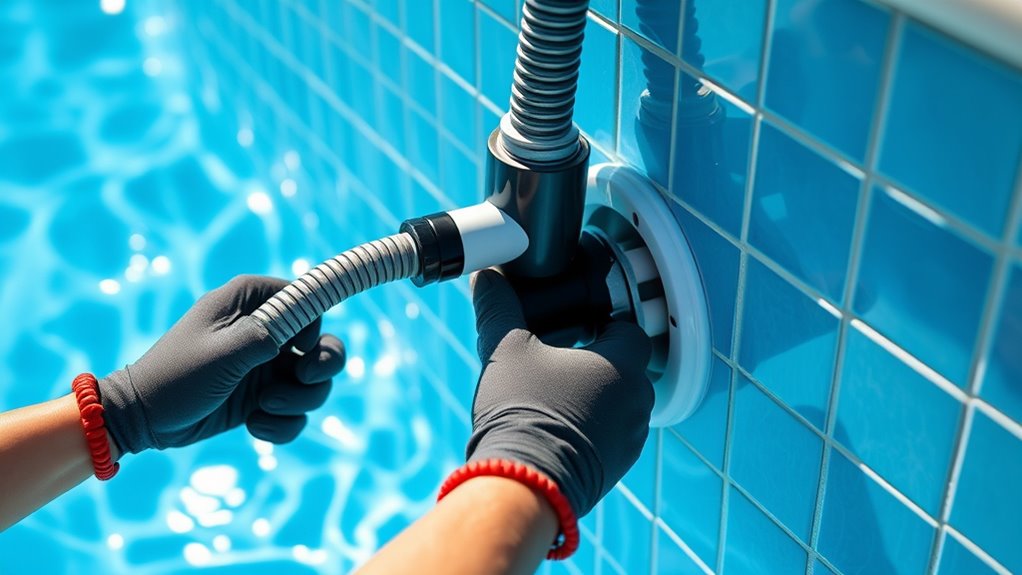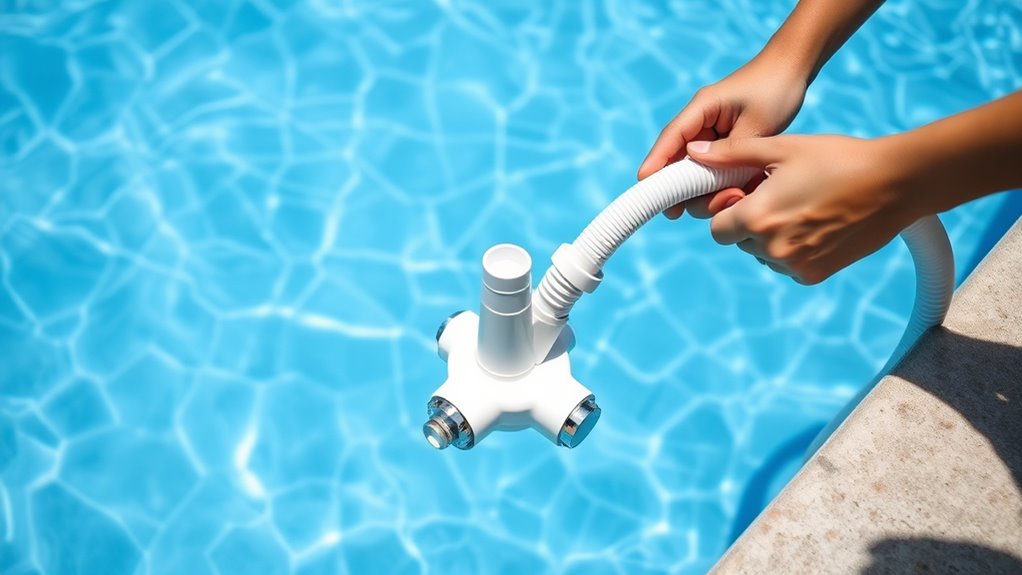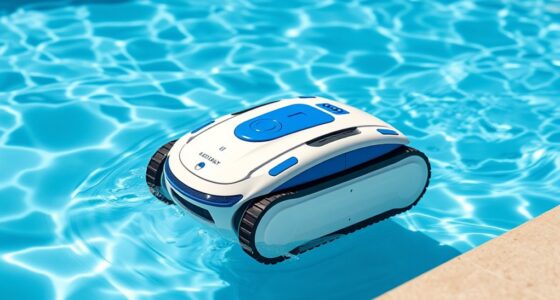To install a suction pool cleaner, start by turning off your pool’s pump and checking the filtration system. Connect the cleaner to the skimmer or a dedicated suction line, making sure all hose fittings are tight without kinks. Fill the hose with water to remove air, then attach it securely to the cleaner. Turn the pump back on and observe its movement—adjust the hose length if needed. Keep an eye out for leaks or obstructions to guarantee smooth operation as you learn more.
Key Takeaways
- Turn off the pool pump and gather all parts before beginning installation.
- Connect the cleaner to the skimmer or dedicated suction line, ensuring secure and tight fittings.
- Fill the hose with water and submerge it to remove air before attaching to the cleaner.
- Attach the cleaner to the hose securely, then reconnect the pool pump and turn it on.
- Observe the cleaner’s movement, recheck connections, and adjust hose length for optimal coverage.

Installing a suction pool cleaner might seem intimidating at first, but with the right steps, you can have it up and running quickly. Proper installation guarantees your cleaning equipment works efficiently, making pool maintenance less of a chore. First, gather all necessary parts, including the cleaner, hoses, and any adapters that come with your device. Before starting, turn off your pool’s pump to prevent debris from circulating during setup. Check your pool’s filtration system to guarantee it’s clean and functioning well, as a good filter helps your cleaner perform at its best.
Next, locate the suction port or skimmer fitting where the cleaner will attach. Most suction pool cleaners connect directly to the skimmer or dedicated suction line. If your pool has a dedicated suction line, attach the cleaner’s hose directly to it. Otherwise, connect the hose to the skimmer, making sure the connection is tight and secure. When connecting the hose, avoid kinks or twists that could restrict water flow. It’s important to adjust the hose length so it’s just long enough to reach the pool’s bottom without excessive slack. A hose that is too long can tangle or cause the cleaner to lose suction, while one that’s too short won’t cover the entire pool surface.
Once the hose is connected, submerge it in the pool to remove air bubbles, which can impede suction. Allow the hose to fill with water before attaching it to the cleaner, ensuring a smooth water flow. After filling, attach the cleaner to the hose, making sure all connections are secure. Turn the pool pump back on and observe the cleaner’s movement. It should start moving around smoothly, covering the pool surface systematically. If it stalls or doesn’t move properly, double-check all hose connections for leaks or obstructions. Adjust the hose length if necessary to improve mobility.
Additionally, understanding the importance of contrast ratio can help you ensure your pool’s lighting and clarity are optimal during cleaning sessions. Regular maintenance of your pool’s filtration system and understanding industry trends can also contribute to better cleaning results over time. It’s also beneficial to periodically inspect your equipment for wear and tear, which can affect performance. Proper installation not only makes your pool cleaning equipment more effective but also extends its lifespan. To further optimize your setup, consider the latest innovations in pool cleaning technology. A comprehensive understanding of resources and training can help you troubleshoot issues more effectively and improve your overall maintenance routine. Finally, monitor the cleaner during its initial operation to confirm everything is working correctly. Regularly inspect the cleaning equipment for blockages or debris that might clog the intake. Proper installation not only makes your pool cleaning equipment more effective but also extends its lifespan. With a little attention to detail, you’ll keep your pool sparkling and reduce the time spent on pool maintenance. Once installed correctly, your suction pool cleaner will become a reliable part of your routine, making pool care simpler and more efficient.
Frequently Asked Questions
Can I Use a Suction Pool Cleaner on a Saltwater Pool?
You can definitely use a suction pool cleaner on a saltwater pool. Just keep an eye on your pool chemistry, as saltwater can affect your pool’s equipment over time. Make certain your cleaner has strong suction power to handle the salt and debris efficiently. Regularly check and clean the filter, and monitor the salt levels to keep everything running smoothly. This way, your cleaner works well without any issues.
How Often Should I Replace the Cleaner’S Filter or Bag?
Oh, the thrill of filter maintenance—your favorite pastime! You should replace your suction pool cleaner’s filter or bag regularly, ideally based on your replacement schedule, which depends on usage and debris levels. Check it weekly, and if it’s full or clogged, swap it out. Consistent filter maintenance guarantees your cleaner runs smoothly and keeps your pool sparkling, preventing unnecessary wear and tear. Trust the schedule, and enjoy pristine water effortlessly!
Will a Suction Cleaner Work on an Uneven Pool Floor?
A suction cleaner can work on an uneven surface, but its effectiveness depends on the pool contours. If your pool has sharp dips or complex contours, the cleaner may miss some spots or struggle to maintain contact. To improve performance, choose a model designed for uneven surfaces, and verify the suction is properly adjusted. Regularly check that the cleaner is making good contact with all areas of your pool.
Is There a Recommended Minimum Pool Size for Suction Cleaners?
Did you know that over 60% of pool owners prefer suction cleaners for their efficiency? When considering your pool size, there’s no strict minimum, but larger pools may need more powerful or multiple cleaners for maximum coverage. Check your cleaner’s compatibility with your pool size to guarantee it operates effectively. Smaller pools are easier to clean with suction models, but always match your pool size with your cleaner’s capacity for the best results.
Can I Leave the Cleaner in the Pool When Not in Use?
You can leave your suction pool cleaner in the pool when not in use, but it’s best to follow storage tips to prolong its life. Rinse and dry it thoroughly, then store it in a cool, shaded area. Regular maintenance schedule checks help guarantee peak performance. Removing the cleaner periodically prevents buildup and damage, making it easier to keep your pool clean and your equipment in excellent condition.
Conclusion
So, after all that effort, you’ve installed your suction pool cleaner. Now, you can sit back and marvel at how effortlessly it’s supposed to keep your pool spotless—if only it worked perfectly. Sometimes, all that work feels a bit pointless when the cleaner decides to play hide and seek or just refuses to cooperate. But hey, at least you’ll get your steps in, right? Turns out, cleaning the pool is the real workout!










